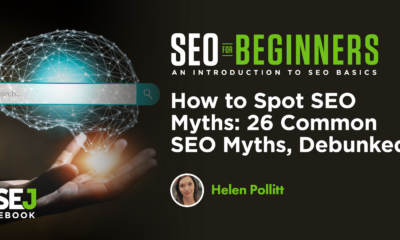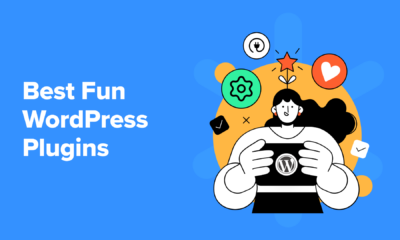SEO
25 Surefire Signs You’re Dealing With A Client From Hell

We’ve all heard the stories… and sadly, most of us have lived one or two of them, as well.
They range from high maintenance and unreasonable to demanding, insulting, and just plain rude.
They’re the clients from hell.
I have my own client from hell story or two – okay, more than two.
Getting out of these situations can be a nightmare.
So how do you avoid getting into them in the first place?
Don’t ignore the red flags!
Check out these 25 major warning signs that you might be dealing with a client from hell.
1. They Insult You
“Are you sure you know what you’re doing?” is an early warning sign that your expertise won’t be respected.
And that’s if you’re dealing with a client from hell who has a little bit of self-control.
The worst of the worst won’t hold back when it comes to using colorful language.
2. They Email You On The Weekend & Expect A Response
Some clients use the weekends to get ahead on projects.
While it’s okay to send emails during this timeframe (using a scheduling tool like Boomerang is better), it’s not alright for them to expect an immediate response.
Head off this potential issue by discussing “office hours” with each client.
These are specific times they can expect a response (e.g.: 9am-5pm, Monday-Friday), as well as your average response time for emails (e.g.: 24-48 hours during the week).
3. They Text You & Expect An Immediate Response
Be wary of the client who’s always trying to text you.
Besides the fact that it’s annoying and bleeds into your out-of-office time, it’s always easier to manage responses (and items in need of follow-up) contained within an email inbox.
Avoid this potential issue by stipulating methods and frequency of communication within your contract.
For example: “With your current plan, you can schedule one included strategy meeting with me per month and unlimited access via email. Any additional meetings will be billed at a rate of $xx/hour.”
4. They Give Zero Direction & Have Endless Revisions
Although it may be your job to develop ideas, that doesn’t mean that your client doesn’t have to chime in regarding some sort of template or framework for the final deliverable they’re looking for.
If they insist that you move forward regardless, you’re looking at endless revisions – perhaps not covered by the scope of work initially quoted.
Head off this potential issue with some sort of intake process that includes questions designed to get this information from your client.
Before starting on any new project, define the total number of revisions included in your rate in the contract.
If you still think that you may be in the process of signing a client from hell, make sure to get payment upfront.
You don’t want them stiffing you if they’re still unhappy when the project is completed.
5. They Send Passive Aggressive Emails
Elements of a conversation sometimes get lost in written communications.
You might think that a client is giving you lip, but it could also just be the way they come across over email.
But, if you’re getting more “Please advise” messages than “Great work!” it might be a sign that you’re dealing with a client from hell.
If you detect what you think is passive-aggressiveness on email, don’t wait – get on the phone and sort it out.
If you can’t come to a conclusion over this new medium, it might make sense to part ways.
6. They Have Issues Signing A Contract
Is there a bigger red flag than this?
If they won’t sign a simple contract agreeing to the scope of work and can’t give any specific reasons as to why you’re better off ditching this prospect before they become a bona fide client from hell.
7. They Consistently Pay Late
Even the clients who are the easiest to get along with can become a client from hell when they fail to show you the respect that you deserve.
If you’re dealing with someone who fails to pay on time, it will stress you out and take your focus away from more important things.
Avoid this potential issue by getting payment upfront, whenever possible.
Clearly define payment terms in your contract, alongside a late fee, so that there’s no question as to when your client has agreed to pay you.
8. They Want You To Use (A Bunch Of) Their Tools
Sometimes, working with a new client means an onboarding process that includes being invited to a new project management platform and accounts where you can glean the data that you need to complete the job they hired you for.
Acquiescing to using a few new client tools is to be expected, but being required to learn a bunch of new systems can be extremely time-consuming and hard on your focus.
Head off this potential issue with a great discovery process.
Add this question to your prospecting, “If we were to work together, are there any specific tools I would need to become familiar with and use on a regular basis?”
Based on the client’s answer, you can either build in the cost of getting to know/using these tools – or disqualify them as being a potential headache to deal with.
9. They Have You On A Minute-By-Minute Schedule
…and they want you to report back to them in kind.
These clients from hell will make working with them so annoying that their overbearing nature will inevitably get in the way of getting any work done!
Head off this potential issue by charging a project rate instead of an hourly rate.
Being able to budget for the whole deliverable (as opposed to being worried about variability) will put potential clients from hell at ease – giving you room to breathe and do your job.
10. They Say You Charge Too Much
Maybe you do charge too much, as far as their budget is concerned.
Regardless, someone who puts you down and doesn’t think you’re worth all the hard work you’ve put into developing your skills isn’t someone you’re going to want to have to deal with on a regular basis.
Avoid this potential issue by making your rates (or ranges/minimums) publicly known on your website.
This will deter the clients who don’t have the budget to work with you while advancing the sale with those to whom your rates are not an issue.
11. They Act Like They’re Doing You A Favor By Giving You Crappy Work At Ridiculously Low Prices
Does it even really need to be said?
Avoid this type of client from hell.
Head off this potential issue by staying away from content mills and freelancer platforms like Upwork.
12. They Threaten Your Reputation
Despite your best efforts, there will be situations where a client absolutely hates a deliverable and decides that, instead of giving you the opportunity to make it better, they’d rather publicly smear you.
Set the record straight if a client decides to publicly shame you.
Publish your own account of what happened with simple facts – let readers come to their own conclusions.
That said, you can get into trouble if you initiate any public shaming, so be prepared to drop it if your client keeps their negativity confined to within your private conversations.
13. They Act Weird When You Talk Money Details
If you’re getting a sense that a prospect has issues with your pricing but they’re not coming out and saying it – try directly addressing it.
If you’re still sensing some weirdness, but want to give working with them a try, make sure to charge upfront.
14. They Can’t Answer Simple Questions About Their Business
Even the most pleasant people become clients from hell when they can’t articulate the information you need to know to do your job.
If you’re dealing with someone who has a lot of ideas but doesn’t have the focus to execute any one of them well, it’s a red flag you need to consider.
15. They Don’t Have Time For Small Talk
The best clients start every call with a little idle chit-chat.
This is what separates an awesome client from a client from hell.
If they can’t connect on a human-to-human basis and instead dive straight into business, it’s going to be a tough work environment.
16. They Have Impossible Demands/Requests
“I want to create the next Google” is probably not something that they can achieve based on working with you alone.
That’s not to say that you’re not awesome, just that they have extremely unrealistic expectations.
You might be able to bill them for a few months, but when they realize they won’t ever get what they really want and think that you’ve misled them, the fallout will be more stressful than the pay could ever be worth.
To avoid this potential issue, talk about key performance indicators (KPIs) and goals before work begins.
17. They Don’t Listen To Your Expertise, Then Blame You When Things Go Wrong
So many clients from hell can be described as those that take your deliverable and gut it of all the things you implemented for the direct purpose of achieving their goal.
Your work, now an unrecognizable mess, is no longer optimized for its initial purpose.
Even though it’s not your fault, a client from hell will blame it all on you when things go wrong.
And that should be the last project you complete for them.
18. They Expect Immediate Results From A Long-Term Campaign
Some clients may think it’s “BS” to have to wait for SEO results and may quiz you on progress every day. I mean how long does SEO take?
Head off this potential issue by educating your client as to typical results and when clients can expect to see them.
If there are still issues, you might have to have the “I think we may not be a fit” conversation.
19. They Expect You To Always Be On-Call
Besides immediate responses, they also expect immediate deliverables.
Avoid this potential issue by defining turnaround and rush fees for any accepted projects in need of a turnaround in a shorter time frame.
Stress the importance of your prerogative to reject work within a short turnaround time, especially if it would bleed into your personal life.
Establishing boundaries is important for achieving an ideal work-life balance.
20. They Need You To Be Their Tech Support In Addition To The Job They Actually Hired You For
This is especially relevant when you provide digital marketing services but your client has no idea how it all works.
Head off this potential problem by defining the cost of providing tech support/exceedingly in-depth explanations as to what you’re doing, or ask questions to suss out a potential technophobe client from hell during the discovery process.
21. They Take Credit For Something You Did, To Someone Else At Their Company
Not unlike a corporate job, this type of client from hell can really take the wind out of your sails.
If you’re not interested in credit, this may not be a problem.
Regardless, dealing with a liar can bleed over to include other troublesome client-from-hell warning signs.
22. Unscheduled Calls & Constant Meetings
All clients are different and some may require weekly meetings to stay on top of things.
If that’s defined in your contract and you’ve accounted for it in your pricing, there are no issues.
A client from hell is someone who’s especially needy and hasn’t given you the opportunity to account for all this extra hand-holding in your contract.
If they’re constantly calling you and require additional meetings on top of what’s stipulated in your contract, you’ll want to cut your losses sooner rather than later.
23. They Make You Feel Like You’re In Competition With Other Freelancers/Vendors
If a client is unhappy with the work you create, their feedback should make that obvious.
If they’re unhappy enough to threaten to outsource your role to someone else – let them.
You don’t need someone acting like you’re no good but stringing you along, anyway.
24. They Ask You To Compromise Your Ethics
With increasing privacy/security standards like that of GDPR, it’s more important now than ever to be compliant with the work you’re doing for clients.
If you inform a client that a specific action clearly goes against your ethics, but they ask you to complete it anyway, you’d better get out before you’re implicated in their bad behavior.
25. Their Edits Take Your Work From Great To Tacky
Even if they don’t blame you for what their Frankenstein edits have done to your deliverable, it’s hard to be proud of something that you’ve created if it doesn’t achieve the potential you knew it was capable of.
If a client constantly puts you in a position where your work is transformed into something tacky, you’re better off spending your time looking for someone who appreciates you as you are.
Final Thoughts
Unfortunately, as much as we try to avoid dealing with such horrific clients, you may need to fire a client.
When this time comes, be direct and try to maintain cordial relations.
Use this as a learning opportunity and focus on attracting more of the type of clients that grow your business.
More Resources:
Featured Image: fizkes/Shutterstock
SEO
Google Cautions On Blocking GoogleOther Bot

Google’s Gary Illyes answered a question about the non-search features that the GoogleOther crawler supports, then added a caution about the consequences of blocking GoogleOther.
What Is GoogleOther?
GoogleOther is a generic crawler created by Google for the various purposes that fall outside of those of bots that specialize for Search, Ads, Video, Images, News, Desktop and Mobile. It can be used by internal teams at Google for research and development in relation to various products.
The official description of GoogleOther is:
“GoogleOther is the generic crawler that may be used by various product teams for fetching publicly accessible content from sites. For example, it may be used for one-off crawls for internal research and development.”
Something that may be surprising is that there are actually three kinds of GoogleOther crawlers.
Three Kinds Of GoogleOther Crawlers
- GoogleOther
Generic crawler for public URLs - GoogleOther-Image
Optimized to crawl public image URLs - GoogleOther-Video
Optimized to crawl public video URLs
All three GoogleOther crawlers can be used for research and development purposes. That’s just one purpose that Google publicly acknowledges that all three versions of GoogleOther could be used for.
What Non-Search Features Does GoogleOther Support?
Google doesn’t say what specific non-search features GoogleOther supports, probably because it doesn’t really “support” a specific feature. It exists for research and development crawling which could be in support of a new product or an improvement in a current product, it’s a highly open and generic purpose.
This is the question asked that Gary narrated:
“What non-search features does GoogleOther crawling support?”
Gary Illyes answered:
“This is a very topical question, and I think it is a very good question. Besides what’s in the public I don’t have more to share.
GoogleOther is the generic crawler that may be used by various product teams for fetching publicly accessible content from sites. For example, it may be used for one-off crawls for internal research and development.
Historically Googlebot was used for this, but that kind of makes things murky and less transparent, so we launched GoogleOther so you have better controls over what your site is crawled for.
That said GoogleOther is not tied to a single product, so opting out of GoogleOther crawling might affect a wide range of things across the Google universe; alas, not Search, search is only Googlebot.”
It Might Affect A Wide Range Of Things
Gary is clear that blocking GoogleOther wouldn’t have an affect on Google Search because Googlebot is the crawler used for indexing content. So if blocking any of the three versions of GoogleOther is something a site owner wants to do, then it should be okay to do that without a negative effect on search rankings.
But Gary also cautioned about the outcome that blocking GoogleOther, saying that it would have an effect on other products and services across Google. He didn’t state which other products it could affect nor did he elaborate on the pros or cons of blocking GoogleOther.
Pros And Cons Of Blocking GoogleOther
Whether or not to block GoogleOther doesn’t necessarily have a straightforward answer. There are several considerations to whether doing that makes sense.
Pros
Inclusion in research for a future Google product that’s related to search (maps, shopping, images, a new feature in search) could be useful. It might be helpful to have a site included in that kind of research because it might be used for testing something good for a site and be one of the few sites chosen to test a feature that could increase earnings for a site.
Another consideration is that blocking GoogleOther to save on server resources is not necessarily a valid reason because GoogleOther doesn’t seem to crawl so often that it makes a noticeable impact.
If blocking Google from using site content for AI is a concern then blocking GoogleOther will have no impact on that at all. GoogleOther has nothing to do with crawling for Google Gemini apps or Vertex AI, including any future products that will be used for training associated language models. The bot for that specific use case is Google-Extended.
Cons
On the other hand it might not be helpful to allow GoogleOther if it’s being used to test something related to fighting spam and there’s something the site has to hide.
It’s possible that a site owner might not want to participate if GoogleOther comes crawling for market research or for training machine learning models (for internal purposes) that are unrelated to public-facing products like Gemini and Vertex.
Allowing GoogleOther to crawl a site for unknown purposes is like giving Google a blank check to use your site data in any way they see fit outside of training public-facing LLMs or purposes related to named bots like GoogleBot.
Takeaway
Should you block GoogleOther? It’s a coin toss. There are possible potential benefits but in general there isn’t enough information to make an informed decision.
Listen to the Google SEO Office Hours podcast at the 1:30 minute mark:
Featured Image by Shutterstock/Cast Of Thousands
SEO
AI Search Boosts User Satisfaction

A new study finds that despite concerns about AI in online services, users are more satisfied with search engines and social media platforms than before.
The American Customer Satisfaction Index (ACSI) conducted its annual survey of search and social media users, finding that satisfaction has either held steady or improved.
This comes at a time when major tech companies are heavily investing in AI to enhance their services.
Search Engine Satisfaction Holds Strong
Google, Bing, and other search engines have rapidly integrated AI features into their platforms over the past year. While critics have raised concerns about potential negative impacts, the ACSI study suggests users are responding positively.
Google maintains its position as the most satisfying search engine with an ACSI score of 81, up 1% from last year. Users particularly appreciate its AI-powered features.
Interestingly, Bing and Yahoo! have seen notable improvements in user satisfaction, notching 3% gains to reach scores of 77 and 76, respectively. These are their highest ACSI scores in over a decade, likely due to their AI enhancements launched in 2023.
The study hints at the potential of new AI-enabled search functionality to drive further improvements in the customer experience. Bing has seen its market share improve by small but notable margins, rising from 6.35% in the first quarter of 2023 to 7.87% in Q1 2024.
Customer Experience Improvements
The ACSI study shows improvements across nearly all benchmarks of the customer experience for search engines. Notable areas of improvement include:
- Ease of navigation
- Ease of using the site on different devices
- Loading speed performance and reliability
- Variety of services and information
- Freshness of content
These improvements suggest that AI enhancements positively impact various aspects of the search experience.
Social Media Sees Modest Gains
For the third year in a row, user satisfaction with social media platforms is on the rise, increasing 1% to an ACSI score of 74.
TikTok has emerged as the new industry leader among major sites, edging past YouTube with a score of 78. This underscores the platform’s effective use of AI-driven content recommendations.
Meta’s Facebook and Instagram have also seen significant improvements in user satisfaction, showing 3-point gains. While Facebook remains near the bottom of the industry at 69, Instagram’s score of 76 puts it within striking distance of the leaders.
Challenges Remain
Despite improvements, the study highlights ongoing privacy and advertising challenges for search engines and social media platforms. Privacy ratings for search engines remain relatively low but steady at 79, while social media platforms score even lower at 73.
Advertising experiences emerge as a key differentiator between higher- and lower-satisfaction brands, particularly in social media. New ACSI benchmarks reveal user concerns about advertising content’s trustworthiness and personal relevance.
Why This Matters For SEO Professionals
This study provides an independent perspective on how users are responding to the AI push in online services. For SEO professionals, these findings suggest that:
- AI-enhanced search features resonate with users, potentially changing search behavior and expectations.
- The improving satisfaction with alternative search engines like Bing may lead to a more diverse search landscape.
- The continued importance of factors like content freshness and site performance in user satisfaction aligns with long-standing SEO best practices.
As AI becomes more integrated into our online experiences, SEO strategies may need to adapt to changing user preferences.
Featured Image: kate3155/Shutterstock
SEO
Google To Upgrade All Retailers To New Merchant Center By September

Google has announced plans to transition all retailers to its updated Merchant Center platform by September.
This move will affect e-commerce businesses globally and comes ahead of the holiday shopping season.
The Merchant Center is a tool for online retailers to manage how their products appear across Google’s shopping services.
Key Changes & Features
The new Merchant Center includes several significant updates.
Product Studio
An AI-powered tool for content creation. Google reports that 80% of current users view it as improving efficiency.
This feature allows retailers to generate tailored product assets, animate still images, and modify existing product images to match brand aesthetics.
It also simplifies tasks like background removal and image resolution enhancement.
Centralized Analytics
A new tab consolidating various business insights, including pricing data and competitive analysis tools.
Retailers can access pricing recommendations, competitive visibility reports, and retail-specific search trends, enabling them to make data-driven decisions and capitalize on popular product categories.
Redesigned Navigation
Google claims the new interface is more intuitive and cites increased setup success rates for new merchants.
The platform now offers simplified website verification processes and can pre-populate product information during setup.
Initial User Response
According to Google, early adopters have shown increased engagement with the platform.
The company reports a 25% increase in omnichannel merchants adding product offers in the new system. However, these figures have yet to be independently verified.
Jeff Harrell, Google’s Senior Director of Merchant Shopping, states in an announcement:
“We’ve seen a significant increase in retention and engagement among existing online merchants who have moved to the new Merchant Center.”
Potential Challenges and Support
While Google emphasizes the upgrade’s benefits, some retailers, particularly those comfortable with the current version, may face challenges adapting to the new system.
The upgrade’s mandatory nature could raise concerns among users who prefer the existing interface or have integrated workflows based on the current system.
To address these concerns, Google has stated that it will provide resources and support to help with the transition. This includes tutorial videos, detailed documentation, and access to customer support teams for troubleshooting.
Industry Context
This update comes as e-commerce platforms evolve, with major players like Amazon and Shopify enhancing their seller tools. Google’s move is part of broader efforts to maintain competitiveness in the e-commerce services sector.
The upgrade could impact consumers by improving product listings and providing more accurate information across Google’s shopping services.
For the e-commerce industry as a whole, it signals a continued push towards AI-driven tools and data-centric decision-making.
Transition Timeline
Google states that retailers will be automatically upgraded by September if they still need to transition.
The company advises users to familiarize themselves with the new features before the busy holiday shopping period.
Featured Image: BestForBest/Shutterstock
-

 SEARCHENGINES5 days ago
SEARCHENGINES5 days agoBillions Of Google goo.gl URLs To 404 In The Future
-

 SEO7 days ago
SEO7 days ago26 Common SEO Myths, Debunked
-
SEARCHENGINES4 days ago
Daily Search Forum Recap: July 22, 2024
-

 SEARCHENGINES6 days ago
SEARCHENGINES6 days agoGoogle Core Update Coming, Ranking Volatility, Bye Search Notes, AI Overviews, Ads & More
-

 SEO5 days ago
SEO5 days ago11 Copyscape Alternatives To Check Plagiarism
-

 SEO6 days ago
SEO6 days agoGoogle Warns Of Last Chance To Export Notes Search Data
-

 AFFILIATE MARKETING5 days ago
AFFILIATE MARKETING5 days agoThe Top 5 AI Tools That Can Revolutionize Your Workflow and Boost Productivity
-
SEARCHENGINES3 days ago
Daily Search Forum Recap: July 23, 2024
















You must be logged in to post a comment Login